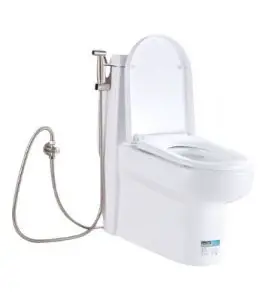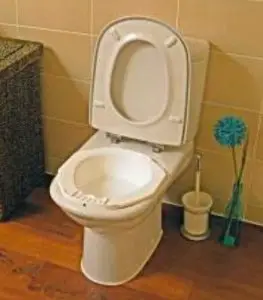What Is a Bidet Toilet?
A bidet toilet is a bathroom fixture designed to wash your private areas with water after using the toilet. Instead of depending only on toilet paper, which can sometimes be rough and leave residue, a bidet uses a gentle stream of water to provide a cleaner and fresher experience.
The term bidet originated in France in the 1600s, where the word meant “pony” because the user had to straddle the small basin like riding a horse. Over the centuries, the design evolved, spreading across Europe, the Middle East, and Asia, where bidets became a standard part of daily hygiene. In fact, in countries like Italy, Japan, and Saudi Arabia, it’s hard to find a bathroom without some form of bidet.
However, in the United States, bidet toilets are still relatively new. Most American households have relied on toilet paper for generations, and only in the last decade have bidets started to gain popularity. Rising awareness about hygiene, sustainability, and comfort has made more families curious about how to use a bidet toilet and why it might be better than paper alone.
Key Features of a Bidet Toilet
Modern bidet toilets have gone far beyond the simple porcelain bowl of the past. Depending on the model, you may find:
- Adjustable spray nozzles for precise cleaning.
- Temperature control to switch between warm and cold water.
- Pressure settings that allow you to choose a soft or strong spray.
- Built-in air dryers that eliminate the need for toilet paper.
- Remote controls or side panels that make operation simple and comfortable.
Why Do People Use Bidets?
The primary purpose of a bidet is improved hygiene. Water simply does a better job of cleaning than paper alone. But there are other reasons:
- Eco-friendliness: A household can save hundreds of rolls of toilet paper each year.
- Cost savings: Less toilet paper means lower monthly expenses.
- Skin comfort: Gentle water is soothing for people with irritation, hemorrhoids, or sensitive skin.
- Accessibility: Elderly people, pregnant women, or those with limited mobility often find bidets much easier to use than wiping with paper.
When learning what a bidet toilet is, it’s important to recognize that it is not a replacement for the toilet itself—it’s a complementary fixture or feature. You still use the toilet as usual, but instead of wiping afterward, you use water for a cleaner finish.
You can check the video on how to use the bidet properly.
Step-by-Step Guide on How to Use A Bidet Toilet
For first-time users, figuring out how to use a bidet toilet may feel a little confusing. Unlike regular toilets, bidets are designed only for washing, not waste disposal. Once you try it, however, the process becomes easy, hygienic, and refreshing. Below is a complete step-by-step guide to help you feel confident.
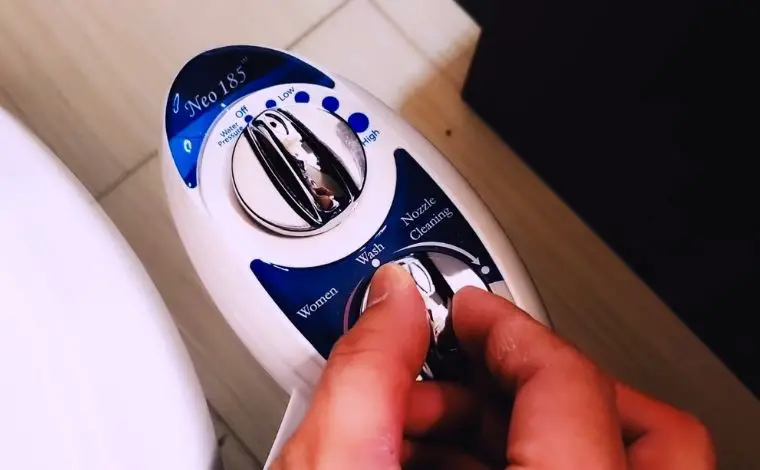
Step 1: Use the Toilet First
Always begin with your regular toilet. The bidet is not a replacement for the toilet—it is meant only for cleaning afterward. Finish your business as usual before moving on to the bidet.
Step 2: Locate the Bidet
Bathrooms may feature different types of bidets. In European homes, you’ll often see a standalone bidet, which looks like a low sink placed beside the toilet. In modern American homes, bidet features are usually built directly into the toilet seat, controlled by a side panel or remote. Some bathrooms also include handheld bidet sprayers, which resemble a small showerhead.
Step 3: Position Yourself Comfortably
Your position depends on the style of bidet:
- Standalone bidet: You may sit facing the controls or away from them, depending on your preference. Facing the controls often makes adjusting the water easier.
- Bidet seat or attachment: Simply remain seated on the toilet, and the nozzle will extend automatically once activated.
- Handheld sprayer: Stay seated and hold the sprayer at an angle that allows the water stream to reach the right spot.
Step 4: Adjust the Water Flow
Start slowly. Turn on the tap or press the control button at a low pressure setting. Sudden, high water flow can be uncomfortable. Once the spray begins, adjust the angle, temperature, and pressure until it feels right. Many modern bidet toilets allow you to switch between warm and cool water for comfort in different seasons.
Step 5: Clean Thoroughly
Let the stream of water wash the area. Most users find that a short rinse is enough, while some prefer a longer cleaning. Remember, the goal is not just hygiene but comfort as well.
Step 6: Dry Yourself
After washing, you’ll need to dry off:
- Use a small amount of toilet paper or a towel.
- If your bidet includes a built-in air dryer, simply press the drying button and wait a few seconds.
Step 7: Wash Your Hands
As with any bathroom activity, always wash your hands afterward. This completes the hygiene routine.
Different Types of Bidet Toilets
When people start researching how to use a bidet toilet, they quickly realize that there isn’t just one type. Bidets come in several designs, each with its own advantages. The right choice depends on your bathroom setup, budget, and comfort preferences. Let’s look at the most common types available today.
1. Electric Bidet Toilets and Seats
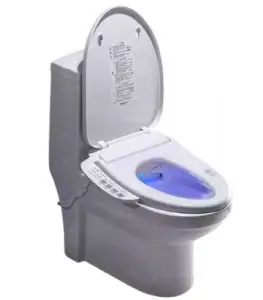 Electric bidets are the most advanced option. They’re often built into modern toilet seats or high-tech toilets, especially popular in Japan. With just the push of a button—or sometimes even a voice command—you can control the water temperature, spray direction, and intensity. Many models also include heated seats, air dryers, deodorizing systems, and night lights for added comfort.
Electric bidets are the most advanced option. They’re often built into modern toilet seats or high-tech toilets, especially popular in Japan. With just the push of a button—or sometimes even a voice command—you can control the water temperature, spray direction, and intensity. Many models also include heated seats, air dryers, deodorizing systems, and night lights for added comfort.
These bidets are perfect for people who want a luxurious bathroom experience and precise control over cleaning. If you’re learning how to use a bidet toilet with electric features, simply remain seated and press the wash function; the nozzle will extend automatically and spray the water at your chosen settings.
2. Non-Electric Bidets
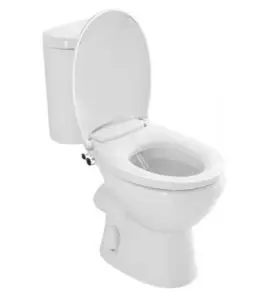 Non-electric bidets are simpler and more affordable. Instead of relying on power, they use your home’s water pressure. You’ll typically find them in the form of attachments or mechanical seats that can be installed directly onto an existing toilet. They often include knobs or levers to adjust the spray.
Non-electric bidets are simpler and more affordable. Instead of relying on power, they use your home’s water pressure. You’ll typically find them in the form of attachments or mechanical seats that can be installed directly onto an existing toilet. They often include knobs or levers to adjust the spray.
The main benefits of non-electric bidets are low cost, easy installation, and reliability. They don’t have features like heated water or air drying, but they still provide excellent cleaning.
3. Handheld Bidet Sprayers
Handheld sprayers—sometimes called bidet hoses or “bum guns”—are common in parts of Asia and the Middle East. They look similar to a small showerhead and are mounted on the wall beside the toilet. To use one, simply aim the sprayer where you need it and press the trigger.
These are especially practical because you control the direction and strength of the spray. They are also very budget-friendly and easy to install, making them popular among travelers and renters.
4. Standalone Bidets
A standalone bidet is the traditional European design. It looks like a low porcelain basin placed beside the toilet. After using the toilet, you move over to the bidet, sit on it, and wash with the built-in taps.
Standalone bidets are elegant but require more bathroom space and separate plumbing. They are less common in modern American homes, but you’ll still find them in many hotels and older houses in Europe.
5. Portable or Travel Bidets
For people who are used to bidets at home, traveling without one can be inconvenient. That’s why portable bidets exist. These small, bottle-like devices have angled nozzles that spray water when squeezed. They’re lightweight, easy to carry, and provide a familiar cleaning method on the go.
Travel bidets are especially useful for campers, frequent flyers, or anyone visiting countries where bidets aren’t common.
Benefits of Using a Bidet Toilet
Once you understand how to use a bidet toilet, the next question is: why should you switch from toilet paper to a bidet? The advantages go far beyond simple cleanliness. From personal comfort to global environmental impact, bidets are proving to be one of the most practical bathroom innovations of our time.
Better Hygiene and Freshness
Water simply cleans more effectively than dry paper. Toilet paper often leaves residue and requires multiple wipes, while a bidet provides a thorough wash in seconds. Many people report feeling noticeably fresher after using a bidet, especially during hot weather or long days.
For women, bidets can also improve feminine hygiene by gently cleaning without harsh wiping. Pregnant women and new mothers often find bidets soothing and more hygienic during recovery.
Eco-Friendly and Sustainable
One of the biggest reasons households are learning how to use a bidet toilet is its positive impact on the environment. Consider this:
- An average American uses nearly 400 rolls of toilet paper per year.
- Producing toilet paper consumes millions of trees and billions of gallons of water annually.
By switching to a bidet, you dramatically reduce the demand for toilet paper, helping save forests and cutting down bathroom waste.
Cost Savings Over Time
Although installing a bidet may seem like an expense at first, it quickly pays for itself. Families can spend hundreds of dollars every year on toilet paper. With a bidet, those costs shrink because you’ll use little or no toilet paper at all. Over several years, the savings add up.
Comfort for Sensitive Skin
People with hemorrhoids, anal fissures, or sensitive skin often find wiping with paper painful and irritating. A gentle stream of water is soothing, reducing discomfort and helping with faster healing. This makes bidets especially valuable for people dealing with long-term skin sensitivity.
Accessibility and Independence
For elderly individuals, people with disabilities, or anyone with limited mobility, learning how to use a bidet toilet can restore independence. Instead of struggling to reach and wipe, users can clean themselves with a simple press of a button or gentle spray from a handheld sprayer.
A Cleaner Bathroom Environment
Using less toilet paper means fewer clogged drains, less mess in trash bins, and fewer plumbing problems. Bathrooms stay cleaner, and you won’t run into emergencies where the toilet paper roll runs out at the worst possible moment.
Common Questions About How to Use a Bidet Toilet
For many first-time users, bidets raise a lot of questions. While they are simple to operate, cultural differences and unfamiliarity can create uncertainty. Below are answers to the most common questions people ask when learning how to use a bidet toilet.
Do You Still Need Toilet Paper?
Not necessarily. With some bidets, especially electric ones that feature built-in air dryers, toilet paper becomes optional. The dryer leaves you clean and dry without needing to wipe. However, with basic models that don’t include a drying system, you may still want to use a small piece of toilet paper or a towel to pat dry. The difference is that you’ll use far less paper than before, reducing waste and cost.
Should You Wipe Before Using a Bidet?
This is a question many beginners have. The truth is, it’s not required. A bidet is designed to wash everything thoroughly on its own. Some people prefer to do a quick initial wipe to shorten rinse time, but it’s a matter of personal comfort. Once you get used to it, you’ll see that wiping first is unnecessary.
Can Women Use a Bidet Safely?
Yes—absolutely. In fact, women often benefit even more from using a bidet. By adjusting the angle of the spray, women can clean both the back and the front hygienically. This is especially useful during menstruation, pregnancy, or postpartum recovery. It’s important, however, to always direct the spray front to back to prevent bacteria from moving toward sensitive areas.
Is the Water Clean?
Yes. Many people are hesitant because they wonder where the water comes from. The answer is simple: bidets use the same clean water supply that feeds your sink and shower. It is not recycled or reused water, so there is no hygiene risk. Once you understand this, it’s easier to relax and enjoy the refreshing wash.
How Do You Dry After Using a Bidet?
Drying depends on the type of bidet toilet:
-
Electric bidets usually have an air-drying feature, which eliminates the need for toilet paper.
-
Non-electric or standalone bidets don’t have dryers, so a small amount of tissue or a personal towel works fine.
The key is that even when you use paper, you’re drying—not wiping—so the amount of paper needed is minimal.
Can You Use a Bidet After Peeing?
Yes, bidets can be used after both bowel movements and urination. Men may adjust their position to wash the front area, while women often find it convenient for refreshing after peeing. Learning how to use a bidet toilet after urination provides an extra level of cleanliness that toilet paper alone cannot achieve.
Final Thoughts on How to Use a Bidet Toilet
Bidet toilets are no longer an unfamiliar luxury seen only in hotels or foreign countries. They are becoming a mainstream choice in modern households across the world. Once you learn how to use a bidet toilet, you’ll discover it’s not only simple but also life-changing in terms of hygiene, comfort, and sustainability.
The key takeaway is that a bidet complements your toilet routine—it doesn’t replace it. After finishing your business, the bidet offers a refreshing wash that toilet paper can never match. With practice, the steps become second nature: position yourself, adjust the water flow, rinse thoroughly, and dry comfortably.
Why You Should Consider a Bidet Toilet
- Better hygiene: A cleaner, fresher feeling every day.
- Eco-friendly living: Dramatically reduced toilet paper waste.
- Cost savings: Lower household expenses over time.
- Accessibility: Easier for elderly people, pregnant women, and those with limited mobility.
- Modern comfort: Features like heated seats, warm water, and air dryers create a spa-like bathroom experience.
The Future of Bathroom Hygiene
As more people become aware of the environmental cost of toilet paper, bidet toilets are gaining popularity in the United States and beyond. In fact, home improvement stores and online retailers now offer affordable bidet attachments that anyone can install within minutes. This growing accessibility makes it easier than ever to upgrade your bathroom.
Final Encouragement
If you’ve never tried one, now is the time to explore how to use a bidet toilet. Start with a simple handheld sprayer or a non-electric attachment, or invest in a high-tech electric seat for the ultimate comfort. No matter which option you choose, the result will be the same: a cleaner, fresher, and more eco-friendly bathroom routine.
Once you experience the difference, you’ll likely wonder how you ever managed without one. Learning how to use a bidet toilet is not just about hygiene—it’s about adopting a smarter, healthier, and more sustainable lifestyle.
Hi, this is Robert Crossan, the owner of this website, has 17 years of experience in the installation, maintenance, and repair of toilets and plumbing systems. After completing the Level 2 Basic Plumbing course in 2005, I started working in both domestic and commercial buildings as a professional plumber. So I can figure out the core difference between different toilet models and brands. It also helped me monitor their work performance and setbacks.
